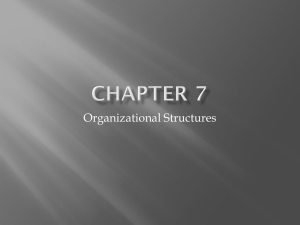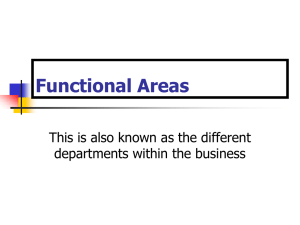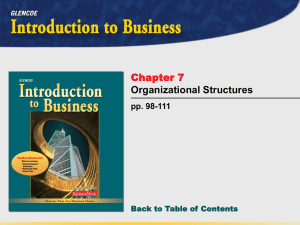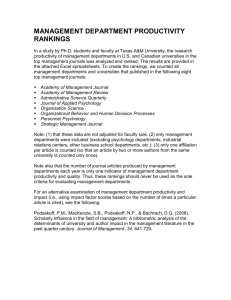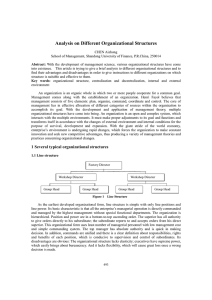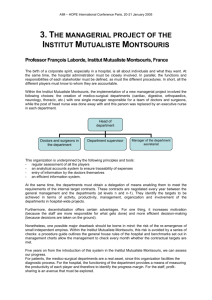Specific Objectives
advertisement
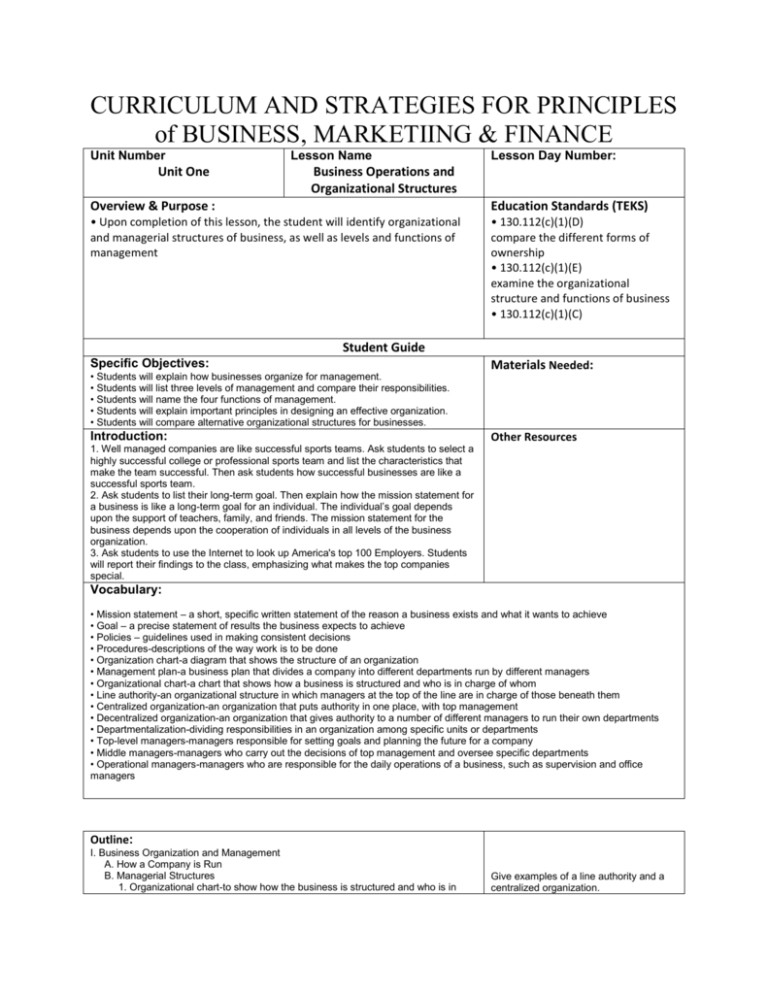
CURRICULUM AND STRATEGIES FOR PRINCIPLES of BUSINESS, MARKETIING & FINANCE Unit Number Unit One Lesson Name Lesson Day Number: Business Operations and Organizational Structures Overview & Purpose : Education Standards (TEKS) • Upon completion of this lesson, the student will identify organizational and managerial structures of business, as well as levels and functions of management • 130.112(c)(1)(D) compare the different forms of ownership • 130.112(c)(1)(E) examine the organizational structure and functions of business • 130.112(c)(1)(C) Student Guide Specific Objectives: • Students will explain how businesses organize for management. • Students will list three levels of management and compare their responsibilities. • Students will name the four functions of management. • Students will explain important principles in designing an effective organization. • Students will compare alternative organizational structures for businesses. Introduction: Materials Needed: Other Resources 1. Well managed companies are like successful sports teams. Ask students to select a highly successful college or professional sports team and list the characteristics that make the team successful. Then ask students how successful businesses are like a successful sports team. 2. Ask students to list their long-term goal. Then explain how the mission statement for a business is like a long-term goal for an individual. The individual’s goal depends upon the support of teachers, family, and friends. The mission statement for the business depends upon the cooperation of individuals in all levels of the business organization. 3. Ask students to use the Internet to look up America's top 100 Employers. Students will report their findings to the class, emphasizing what makes the top companies special. Vocabulary: • Mission statement – a short, specific written statement of the reason a business exists and what it wants to achieve • Goal – a precise statement of results the business expects to achieve • Policies – guidelines used in making consistent decisions • Procedures-descriptions of the way work is to be done • Organization chart-a diagram that shows the structure of an organization • Management plan-a business plan that divides a company into different departments run by different managers • Organizational chart-a chart that shows how a business is structured and who is in charge of whom • Line authority-an organizational structure in which managers at the top of the line are in charge of those beneath them • Centralized organization-an organization that puts authority in one place, with top management • Decentralized organization-an organization that gives authority to a number of different managers to run their own departments • Departmentalization-dividing responsibilities in an organization among specific units or departments • Top-level managers-managers responsible for setting goals and planning the future for a company • Middle managers-managers who carry out the decisions of top management and oversee specific departments • Operational managers-managers who are responsible for the daily operations of a business, such as supervision and office managers Outline: I. Business Organization and Management A. How a Company is Run B. Managerial Structures 1. Organizational chart-to show how the business is structured and who is in Give examples of a line authority and a centralized organization. charge of whom 2. Line authority-managers at the top of the organization are in charge of those beneath them 3. Centralized organizations-puts authority in one place, with top management 4. Decentralized organization-gives authority to a number of different managers to run their own departments C. Types of Organizational Structures 1. Formal Structure-departmentalization divides responsibility among specific units, or departments 2. Informal Structure-used when a business does not need a big marketing or distribution network, does not need a lot of managers (smaller businesses) II. Guidelines for Businesses A. Mission Statement-short, specific written statement of the reason a business exists and what it wants to achieve B. Goal-precise statement of results the business expects to achieve C. Policies-guidelines used in making consistent decisions D. Procedures-descriptions of the way work is to be done E. Principles of Effective Organization 1. Responsibility-the obligation to complete specific work 2. Authority-right to make decisions about how responsibilities should be accomplished 3. Accountability-taking responsibility for the results achieved 4. Unity of Command-clear reporting relationship for all staff of a business 5. Span of Control-number of employees who are assigned to a particular work task and manager F. Types of Organizational Structures (Illustrated by the Organization Chart) 1. Functional Organization Structure-work is arranged within main business functions (production, operations, marketing, human resources) 2. Matrix Organizational Structure-work is structured around specific projects, products, or customer groups G. How Departments are Organized 1. by function 2. by product 3. by location III. Levels of Management A. Top Level Managers 1. set goals 2. plan for the future B. Middle Managers 1. carry out the decisions of top management 2. plan and control operations C. Operational Managers 1. oversee daily operations 2. supervise workers to meet deadlines IV. Planning be done? A. Long-range planning-top-level management decides how the company should perform B. Planning Questions Management Must Address 1. What must be done? 2. Who will do it? 3. How will the work be grouped? 4. Who supervises whom? 5. Who makes decisions about the work to C. Questions of the Planning Process-are applied and answered when leaders meet with the management team V. Organizing A. Assign Managers Different Tasks B. Coordinate Activities of Managers C. Each manager organizes his/her department and knows what other managers are doing D. Must determine who makes decisions and who answers to whom VI. Leading A. Set Standards-so managers know their goals B. Communicate with Managers-to provide guidance and resolve conflicts C. Encourage Employees-offer incentives such as pay raises and promotions VII. Controlling A. Keeping the Company on Track-to meet all goals 1. Keep track of the budget, the schedule, and the quality of the product 2. Monitor employees and review their performance 3. Monitor customer satisfaction Conduct class discussion about the pros and cons of each form of organization. Break the class into small groups. Each group must choose a business and write a mission statement for the business. Ask students to explain why a large span of control may not be good for a business. Go through an example of a business procedure used by a business where students shop. VIII. Managers A. Most Managers 1. Begin their careers as company employees 2. Are promoted after they have gained experience and have shown leadership qualities B. Managerial Qualities 1. Ability to perform varied activities 2. Ability to work under pressure 3. Effective communication 4. Interpersonal skills 5. Ability to gather and use information C. Advantages Associated with Being a Manager 1. Higher earnings 2. Prestige 3. More influence on how the company is run 4. greater control over personal time D. Disadvantages Associated with Being a Manager 1. Take the blame when things go wrong 2. Wrong decisions are costly and can affect numerous employees 3.Can have an adverse affect on relationship with lower-level employees IX. Teamwork A. Collaboration is Important B. Flexibility, Creativity, Good Communication, Shared Goals C. Work as a Team-to accomplish company goals D. Brainstorm for Solutions E. Listen to Team Members Looking Forward: Q: What is line authority, and how does it look on an organizational chart? A: Line authority can be traced in a line from the top of an organization to the bottom. Q: What are three ways in which departments are organized? A: Departments can be organized by function, by product, or by location. Q: What are the primary responsibilities of top-level management? A: Top-level managers set goals and plan for the future. Q: What is the difference between middle managers and operational managers? A: Middle managers carry out the decisions of top management. Operational managers are responsible for the daily operations of the business. Q: What are four managerial functions? A: Four managerial functions are planning, organizing, leading, and controlling. Q: What does good planning require? A: Good planning requires setting realistic goals. Q: What is the function of leading and how does it affect a manager’s job? A: Leading involves creating a vision of your company to inspire employees, setting goals for your manager, communicating, providing guidance and resolving conflicts, teaching, encouraging, and helping each employee reach his or her potential. MANAGEMENT DECISION A popular bakery has two delivery trucks and two drivers. Each truck can deliver up to150 trays of pastries per day. The bakery currently has orders for 280 trays a day from local supermarkets, schools, and hospitals. A new school is opening soon and the bakery expects orders to increase 250 percent. How many trucks and drivers will be needed to cover new deliveries?
